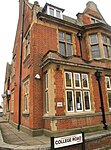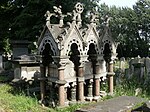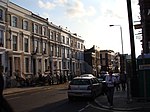Kensal Rise railway station
DfT Category E stationsFormer London and North Western Railway stationsLondon stations without latest usage statistics 1415London stations without latest usage statistics 1516Rail transport stations in London fare zone 2 ... and 4 more
Railway stations in Great Britain opened in 1873Railway stations in the London Borough of BrentRailway stations served by London OvergroundUse British English from August 2012

Kensal Rise is a London Overground station on the North London Line on Chamberlayne Road, Kensal Rise in north-west London. The station is in Travelcard Zone 2.
Excerpt from the Wikipedia article Kensal Rise railway station (License: CC BY-SA 3.0, Authors, Images).Kensal Rise railway station
Station Terrace, London Queen's Park (London Borough of Brent)
Geographical coordinates (GPS) Address Nearby Places Show on map
Geographical coordinates (GPS)
| Latitude | Longitude |
|---|---|
| N 51.5342 ° | E -0.2208 ° |
Address
Station Terrace 4
NW10 5RS London, Queen's Park (London Borough of Brent)
England, United Kingdom
Open on Google Maps






